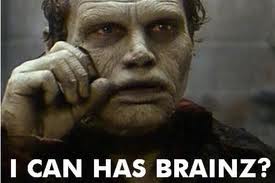(In 2009 I wrote a two-week series of blog posts about post-apocalyptic novels & films for Borders’ blog. Because this subgenre has continued to flourish, I am reprinting the posts here.)
 There is a subgenre of postapocalyptic scenarios that contains all of the elements I’ve previously discussed — societal breakdown, survivalism, moral quandary of looter/ predator vs. self sufficiency and altruism, questions of individual usefulness and the lengths to which you might go to in order to survive, entrenched technophiles vs. barbarians at the gate — and which implicitly contains all those elements’ fascination. But this subgenre also contains an additional element that I believe accounts for its enormous popularity, outpacing all the other end-of-the-world scenarios combined: The zombie apocalypse.
There is a subgenre of postapocalyptic scenarios that contains all of the elements I’ve previously discussed — societal breakdown, survivalism, moral quandary of looter/ predator vs. self sufficiency and altruism, questions of individual usefulness and the lengths to which you might go to in order to survive, entrenched technophiles vs. barbarians at the gate — and which implicitly contains all those elements’ fascination. But this subgenre also contains an additional element that I believe accounts for its enormous popularity, outpacing all the other end-of-the-world scenarios combined: The zombie apocalypse.
Zombie movies and books existed well before George Romero got hold of them and forever changed the iconography of the walking dead in the popular consciousness in Night of the Living Dead and Dawn of the Dead. Plenty of earlier works featured zombies, usually as bastardized or misunderstood interpretations of the Vodoun zombi, a corpse reanimated by a possessing spirit. These were inevitably depicted as mindless shambling slaves, and the horror they contained for their audience was the fear of being a hypnotized acolyte, a helpless laborer.
What Romero brought to this party was global contagion, insatiable flesh-gnoshing, and the zombie equivalent of a vampire’s wooden stake or a werewolf’s silver bullet: The Bullet in the Head. Suddenly zombies weren’t isolated creepies a la The Mummy, they were everywhere, they were hard to stop, they wanted to eat you, and you could become one of them. All humanity was now Other, estranged, alienated, paranoid, susceptible.
This aspect wasn’t entirely original with Romero. Change “vampire” to “zombie” in Matheson’s classic I Am Legend and you pretty much have Dawn of the Dead, published in 1954. So what’s the difference? What made post-Romero zombies the mac daddy of apocalypse scenarios?
When the original Battlestar Galactica was in production, the network wouldn’t allow the depiction of wholesale slaughter of humanoid creatures, especially as the show’s demographic was considered to skew young. The solution was to create a race of robots: The Cylons. Because you can slag robots till your trigger finger just won’t pull anymore and no one will bat an eye. Not even the network standards & practices people.
Zombies are Cylons. They’re people you have permission to kill. Because they ain’t people no more. And the standards & practices people of society at large not only won’t bat an eye when you slaughter them, they’ll cheer you on as a champion of the human race.
It’s no coincidence that zombie-hunting scenarios have long enjoyed videogame popularity. Here’s a first-person shooter that lets you make gnarly blue heads eat hot lead to your heart’s content and not feel a twinge of regret about it. Hell, you’re a hero.
The zombie apocalypse doesn’t just make you ask What would I do? It makes you say Hell yes I’d do it! Gimme a crowbar — I’m gonna bust into that gunshop. It’s no accident these books and movies emphasize variety and novelty — sometimes black-comedically — in the depiction of ways to whack deadheads. You get to act out your every free-floating hostility, every pent-up road-rage fantasy, every hell-with-all-of-you impulse. You have a free ticket to go postal. You get the hot babe and the Escape Chopper.
Zombies. The apocalypse we can all greet wtih open arms and loaded guns.